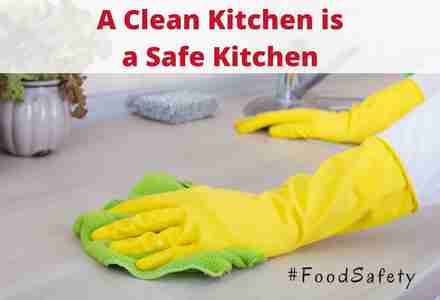Have you gotten the spring cleaning urge yet? Since the weather hasn’t quite warmed up for outdoor activities, now is a great time to clean your kitchen. Cleaning is the first step for preventing illnesses and keeping germs out of your food. And a clean and organized kitchen is more inviting for cooking at home, the best strategy for eating smart.

Basic Kitchen Cleaning
At a minimum, you should be doing these tasks to keep your kitchen clean, sanitized, and organized. These steps keep your work surfaces and food storage areas free from germs that can make your family sick. It may seem like a lot, but for most kitchens, this will take just 10-15 minutes a day. To save money, you can mix your own sanitizing solution.
Wash your hands. Wash your hands before cooking and after touching potentially contaminated surfaces.
Wash your counters, stovetop, and sink. Use warm soapy water or a sanitizing solution to wipe your counters, stovetop, and sink before and after cooking. Clean up any spills immediately. Be sure to wipe under items stored on counters, such as toasters or flour containers. And don’t forget to wipe down the knobs on your stove.
Wash your cutting boards and cooking utensils. Use warm soapy water to wash cutting boards, knives, spoons, spatulas, etc. after using. If you are prepping meat and veggies, you’ll need to wash everything that touched the raw meat, poultry, fish, or eggs before using it again for fruits, veggies, or ready to eat foods.
Wash your fridge and microwave regularly. Aim to wipe down your Aim to wipe down your fridge and microwave (inside and out) with warm soapy water or a sanitizing solution every week. Wipe up any spills immediately.
Sweep, mop, and take out the trash regularly. Keeping your floors and trash cans clean helps keep pests away. You’ll also want to keep the floors clean for little ones who might get the urge to taste things they find lying on the floor.
Sanitize and replace dish sponges or rags and kitchen towels regularly. Germs love warm, wet surfaces like sponges or towels. You can read how to Germs love warm, wet surfaces like sponges or towels. You can read how to sanitize these items here
Wash reusable grocery bags regularly. Wash bags anytime they’re used for meat, poultry, fish or eggs. Read more advice to Wash bags anytime they’re used for meat, poultry, fish or eggs. Read more advice to keep reusable bags clean here . Most of my reusable bags were giveaways, so I didn’t get to choose them, but I prefer machine washable ones for convenience.
Deep Kitchen Cleaning
Try to do these a few times a year. Scheduling your kitchen deep cleaning session when the seasons change can help you remember.
Organize and wash freezer. Wash with warm soapy water. Organize freezer items and use older items first.
Organize and wash pantry and cupboards. Going one at a time, take out everything in your cabinets and pantry. Wash with warm soapy water – inside, outside, and handles or knobs. Put everything back neatly, with older foods in the front and newer foods in the back. Toss any expired or damaged food. This will help you use the “first in, first out” FIFO method. For kitchen equipment, dishes, utensils, etc., organize things you use often in the front to make them handy to access. If you have items you never use, consider donating to a thrift store or giving to a friend or family member who might use it.
Clean the oven and burners. Your oven might have a self-cleaning function. Otherwise, follow these steps for a gas oven or an electric oven.
Now that your kitchen is nice and clean, cooking at home will be easier and safer. After deep cleaning, spending a few minutes each day on basic cleaning tasks will keep it cleaner and your next deep cleaning session will be that much easier. Bonus tip: household chores, like cleaning your kitchen, vacuuming, sweeping, and mopping count as moderate physical activity!












